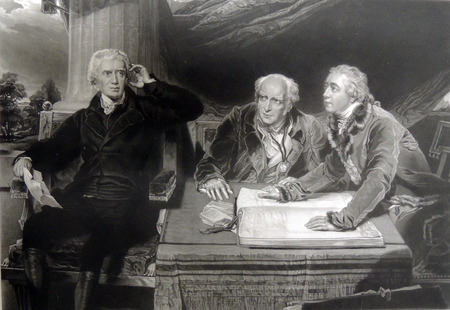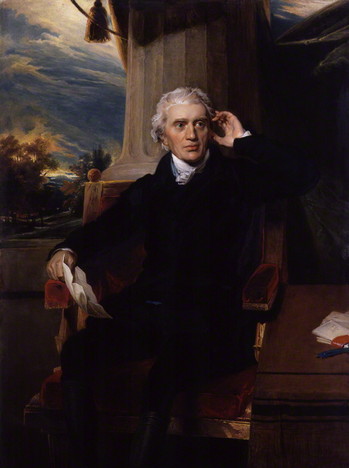Sir Thomas Lawrence (1769-1830), The Baring Family, September 1, 1842. Mezzotint. Graphic Arts Collection, GA 2005.00680
Sir Francis Baring, 1st Baronet (1740-1810), a British merchant and director of the East India Company, is seen on the left, seated with a letter in his right hand. In the center is his brother John Baring (1742-1829) and leaning over the ledger on the right is Charles Wall (1756-1815), a partner in Baring’s Bank and son-in-law to Sir Francis.
Lawrence called portraits like this one “half-history pictures,” combining standard portraiture with the highest level of art, history painting. “Lawrence’s triple portrait … makes you feel like a witness to some grand event, with all the tension, excitement and gravity of history in the making,” writes Sylviane Gold. “Lawrence, like all successful portrait painters, knew how to make his sitters look important. In this case, it wasn’t hard. They were. (The banking trio, after all, provided funds for the Louisiana Purchase, among other epoch-making deals.)” -The New York Times April 23, 2011.
Why does the ledger say “Hope”?
Charles Muss, after Sir Thomas Lawrence, Sir Francis Baring, 1st Bt, 1823. Enamel on bombé copper panel. (c) National Portrait Gallery, London. NPG 1256
Thomas Lawrence, Sir Francis Baring, 1st Baronet, John Baring and Charles Wall, 1806-1807. Oil on canvas. Private Collection
See also: Sir Francis Baring (1740-1810), Observations on the establishment of the Bank of England: and on the paper circulation of the country (London: Printed at the Minerva Press for Sewell and Debrett, 1797). Rare Books (Ex) HG2994.B23



Wikipedia's entry for Sir Francis says:
"Throughout Baring's lifetime his good commercial intelligence, sound judgement, nimble-footedness, and instinct for speculative profit remained the hallmarks of his business style. Thousands of speculations detailed in his firm's ledgers attest to this, but his burgeoning business and rising confidence were graphically illustrated in 1787 when Hope & Co. introduced him to speculation on a grand scale. The two houses set about controlling the entire European cochineal market by secretly buying up all available stocks, one quarter for Barings and the rest for Hopes..."